1 Organising life on earth
On this page
In scientific terms, phylogeny is the evolutionary history and relationship of an organism or group of organisms. A phylogeny describes the organism’s relationships, such as from which organisms it may have evolved, or to which species it is most closely related. Phylogenetic relationships provide information on shared ancestry but not necessarily on how organisms are similar or different. Understanding the principles of phylogeny in veterinary science is important as it enables veterinarians to predict the function and effectiveness of treatments based on evolutionary relationships. This approach helps to develop effective treatment plans by leveraging the similarities in physiology and genetics among related species.
Phylogenetic trees
Scientists use a tool called a phylogenetic tree to show the evolutionary pathways and connections among organisms. A phylogenetic tree is a diagram used to reflect evolutionary relationships among organisms or groups of organisms. Scientists consider phylogenetic trees to be a hypothesis of the evolutionary past since one cannot go back to confirm the proposed relationships. In other words, we can construct a “tree of life” to illustrate when different organisms evolved and to show the relationships among different organisms (Figure 1.1).
Unlike a taxonomic classification diagram, we can read a phylogenetic tree like a map of evolutionary history. Many phylogenetic trees have a single lineage at the base representing a common ancestor. Scientists call such trees rooted, which means there is a single ancestral lineage (typically drawn from the bottom or left) to which all organisms represented in the diagram relate. Notice in the rooted phylogenetic tree that the three domains— Bacteria, Archaea, and Eukarya—diverge from a single point and branch off. The small branch that plants and animals (including humans) occupy in this diagram shows how recent and small these groups are compared with other organisms. Unrooted trees do not show a common ancestor but do show relationships among species.

In a rooted tree, the branching indicates evolutionary relationships (Figure 1.2). The point where a split occurs, a branch point, represents where a single lineage evolved into a distinct new one. We call a lineage that evolved early from the root that remains unbranched a basal taxon. We call two lineages stemming from the same branch point sister taxa. A branch with more than two lineages is a polytomy and serves to illustrate where scientists have not definitively determined all of the relationships. Note that although sister taxa and polytomy do share an ancestor, it does not mean that the groups of organisms split or evolved from each other. Organisms in two taxa may have split at a specific branch point, but neither taxon gave rise to the other.
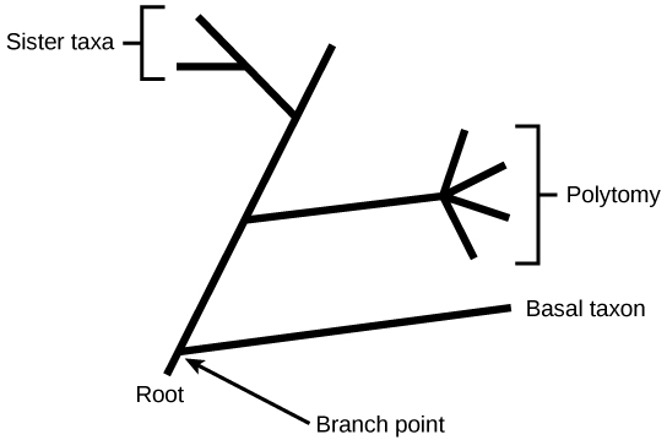
The diagrams above can serve as a pathway to understanding evolutionary history. We can trace the pathway from the origin of life to any individual species by navigating through the evolutionary branches between the two points. Also, by starting with a single species and tracing back towards the “trunk” of the tree, one can discover species’ ancestors, as well as where lineages share a common ancestry. In addition, we can use the tree to study entire groups of organisms.
Another point to mention on phylogenetic tree structure is that rotation at branch points does not change the information. For example, if a branch point rotated and the taxon order changed, this would not alter the information because each taxon’s evolution from the branch point was independent of the other.
Many disciplines within the study of biology contribute to understanding how past and present life evolved over time; these disciplines together contribute to building, updating, and maintaining the “tree of life.” Systematics is the field that scientists use to organise and classify organisms based on evolutionary relationships. Researchers may use data from fossils, from studying the body part structures, or molecules that an organism uses, and DNA analysis. By combining data from many sources, scientists can construct an organism’s phylogeny. Since phylogenetic trees are hypotheses, they will continue to change as researchers discover new types of life and learn new information.
Limitations of phylogenetic trees
It may be easy to assume that more closely related organisms look more alike, and while this is often the case, it is not always true. If two closely related lineages evolved under significantly varied surroundings, it is possible for the two groups to appear more different than other groups that are not as closely related. For example, the dichotomous key in Figure 1.3 shows that lizards and rabbits both have amniotic eggs; whereas, frogs do not. Yet lizards and frogs appear more similar than lizards and rabbits.
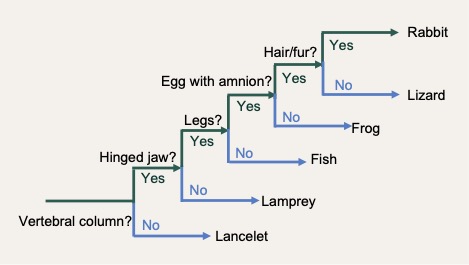
Another aspect of phylogenetic trees is that, unless otherwise indicated, the branches do not account for length of time, only the evolutionary order. In other words, a branch’s length does not typically mean more time passed, nor does a short branch mean less time passed— unless specified on the diagram. For example, in Figure 1.3, the diagram does not indicate how much time passed between the evolution of amniotic eggs and hair. What the tree does show is the order in which things took place. Again using Figure 1.3, this shows that the oldest trait is the vertebral column, followed by hinged jaws, and so forth. However, any phylogenetic tree is a part of the greater whole, and like a real tree, it does not grow in only one direction after a new branch develops. Thus, for the organisms in Figure 1.3, just because a vertebral column evolved does not mean that invertebrate evolution ceased. It only means that a new branch formed. Also, groups that are not closely related, but evolve under similar conditions, may appear more phenotypically similar to each other than to a close relative.
Dive deeper
Use the Interactive Tree Of Life tool to explore the evolutionary relationships among species.
Classification levels
Taxonomy (which literally means “arrangement law”) is the science of classifying organisms to construct internationally shared classification systems with each organism placed into increasingly more inclusive groupings or ‘taxa’. Think about a grocery store’s organisation. One large space is divided into departments, such as produce, dairy, and meats. Then each department further divides into aisles, then each aisle into categories and brands, and then finally a single product. We call this organisation from larger to smaller, more specific categories a hierarchical system.
The taxonomic classification system (also called the Linnaean system after its inventor, Carl Linnaeus, a Swedish botanist, zoologist, and physician) uses a hierarchical model. Moving from the point of origin, the groups become more specific, until one branch ends as a single species. For example, after the common beginning of all life, scientists divide organisms into three large categories called domains: Bacteria, Archaea, and Eukarya. Within each domain is a second category called a kingdom. After kingdoms, the subsequent categories of increasing specificity are: phylum, class, order, family, genus, and species (Figure 1.4).
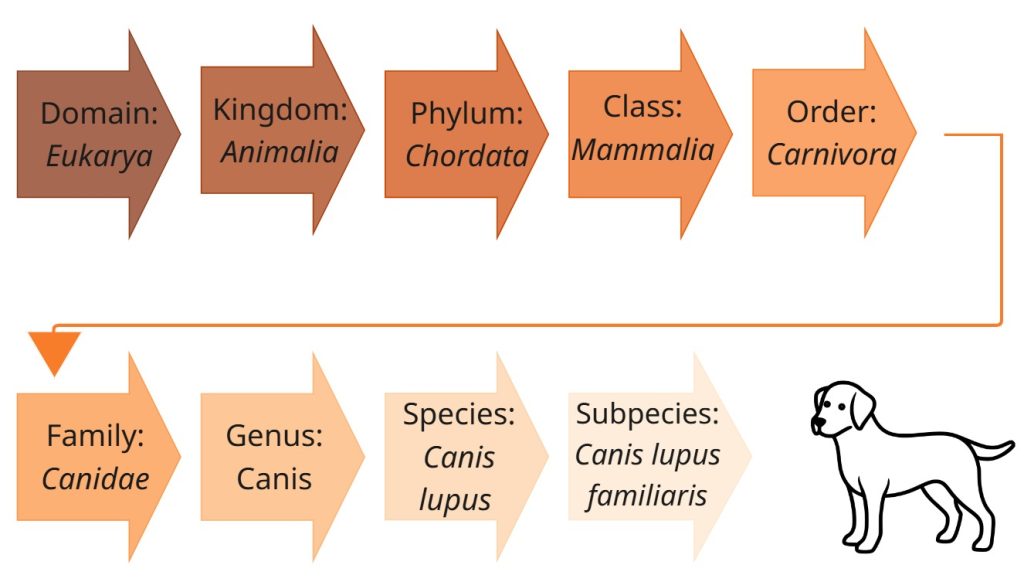
The kingdom Animalia stems from the Eukarya domain and the full name of an organism technically has eight terms. For the dog it is: Eukarya, Animalia, Chordata, Mammalia, Carnivora, Canidae, Canis, and lupus. Notice that each name is capitalised except for species, and the genus and species names are italicised. Scientists generally refer to an organism only by its genus and species, which is its two-word scientific name, or binomial nomenclature. Therefore, the scientific name of the dog is Canis lupus. The name at each level is also a taxon. In other words, dogs are in order Carnivora. Carnivora is the name of the taxon at the order level; Canidae is the taxon at the family level, and so forth. Organisms also have a common name that people typically use, in this case, dog. Note that the dog is additionally a subspecies: the “familiaris” in Canis lupus familiaris. Subspecies are members of the same species that are capable of mating and reproducing viable offspring, but they are separate subspecies due to geographic or behavioural isolation or other factors.
Figure 1.5 shows how the levels move toward specificity with other organisms. Notice how the dog shares a domain with the widest diversity of organisms, including plants and butterflies. At each sublevel, the organisms become more similar because they are more closely related. Historically, scientists classified organisms using characteristics, but as DNA technology developed, they have determined more precise phylogenies.
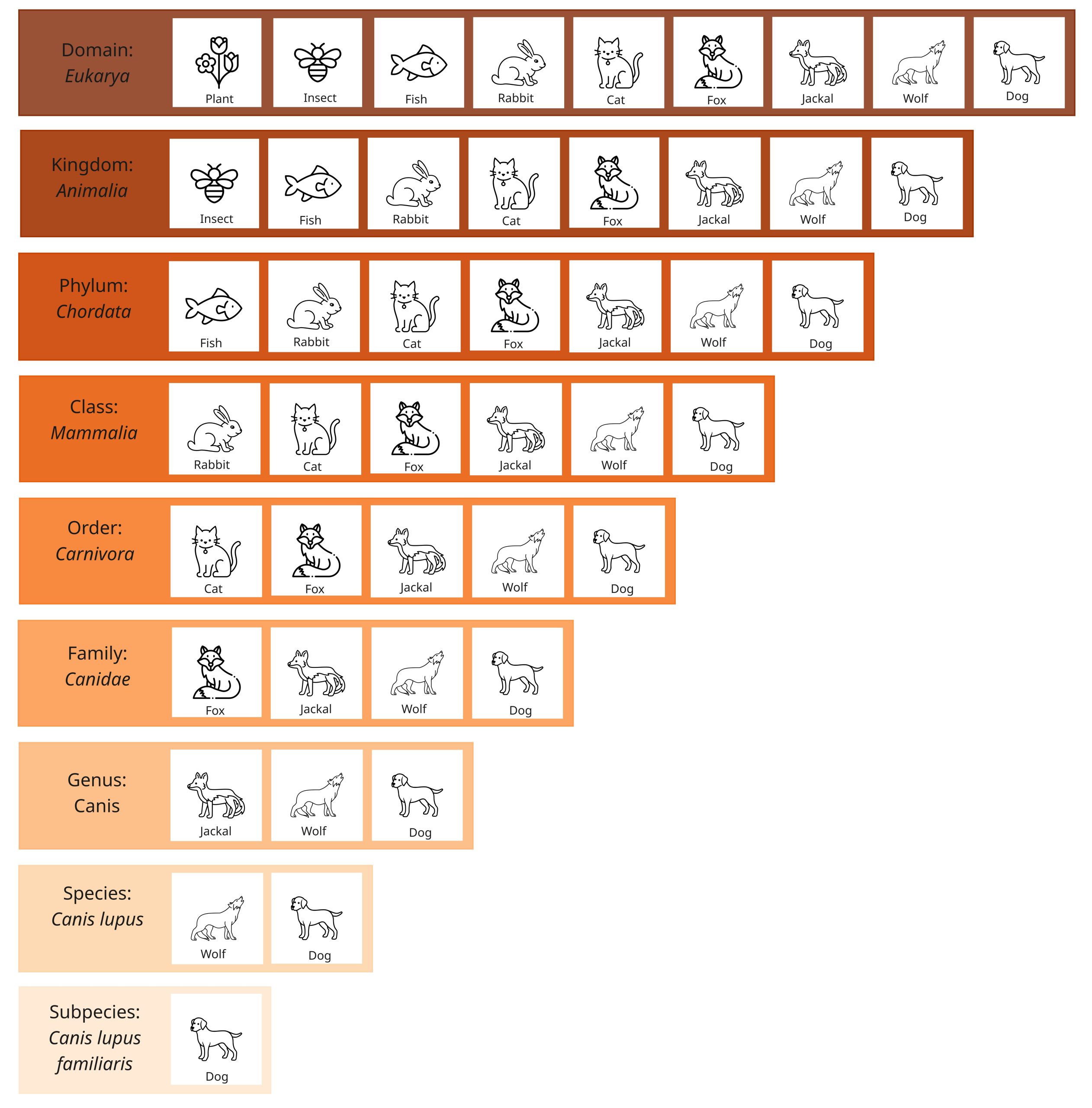
 Reflective question
Reflective question
At what levels are cats and dogs part of the same group?
Dive deeper
Use the National Center for Biotechnology Information’s Taxonomy Browser tool to explore the classifications of thousands of organisms. This reference site contains about 10% of the described species on the planet.
Recent genetic analysis and other advancements have found that some earlier phylogenetic classifications do not align with the evolutionary past; therefore, researchers must make changes and updates as new discoveries occur. Recall that phylogenetic trees are hypotheses and are modified as data becomes available. In addition, classification historically has focused on grouping organisms mainly by shared characteristics and does not necessarily illustrate how the various groups relate to each other from an evolutionary perspective. For example, despite the fact that a hippopotamus resembles a pig more than a whale, the hippopotamus may be the whale’s closest living relative.
Application in veterinary sciences: Two options for similarities
In the case of phylogeny, evolutionary investigations focus on two types of evidence: morphologic (form and function) and genetic. In general, organisms that share similar physical features and genomes are more closely related than those that do not. We refer to such features that overlap both morphologically (in form) and genetically as homologous structures. They stem from developmental similarities that are based on evolution. For example, the bones in bat and bird wings have homologous structures. This is an example of morphological homology (Figure 1.6).
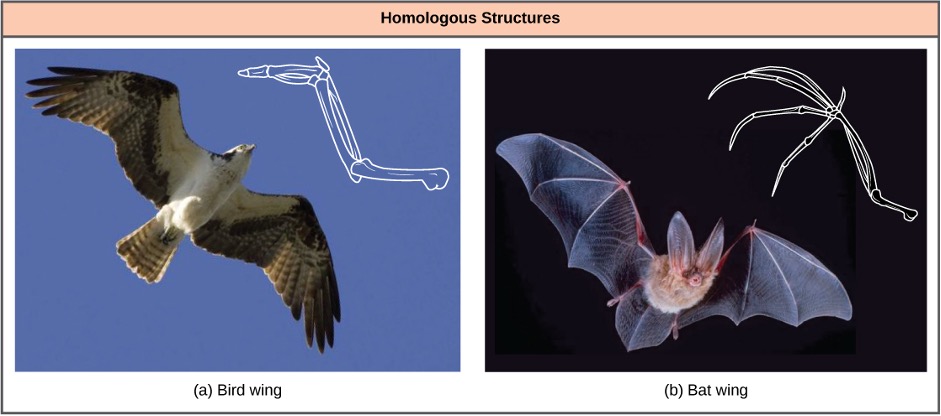
Notice it is not simply a single bone, but rather a grouping of several bones arranged in a similar way. The more complex the feature, the more likely any kind of overlap is due to a common evolutionary past. Imagine two people from different countries both inventing a car with all the same parts and in exactly the same arrangement without any previous or shared knowledge. That outcome would be highly improbable. However, if two people both invented a hammer, we can reasonably conclude that both could have the original idea without the help of the other. The same relationship between complexity and shared evolutionary history is true for homologous structures in organisms.
Some organisms may be very closely related, even though a minor genetic change caused a major morphological difference to make them look quite different. Similarly, unrelated organisms may be distantly related, but appear very much alike. This usually happens because both organisms share common adaptations that evolved within similar environmental conditions. When similar characteristics occur because of environmental constraints and not due to a close evolutionary relationship, it is an analogy or homoplasy. For example, insects use wings to fly like bats and birds, but the wing structure and embryonic origin is completely different. These are analogous structures (Figure 1.7). On the other side, the bird and bat wings are homologous because the bones are inherited from a common ancestor, while the wings themselves are analogous as they evolved independently.
Similar traits can be either homologous or analogous. Homologous structures share a similar embryonic origin. Analogous organs have a similar function. For example, the bones in a whale’s front flipper are homologous to the bones in the human arm. These structures are not analogous. A butterfly or bird’s wings are analogous but not homologous. Scientists must determine which type of similarity a feature exhibits to decipher the organisms’ phylogeny.
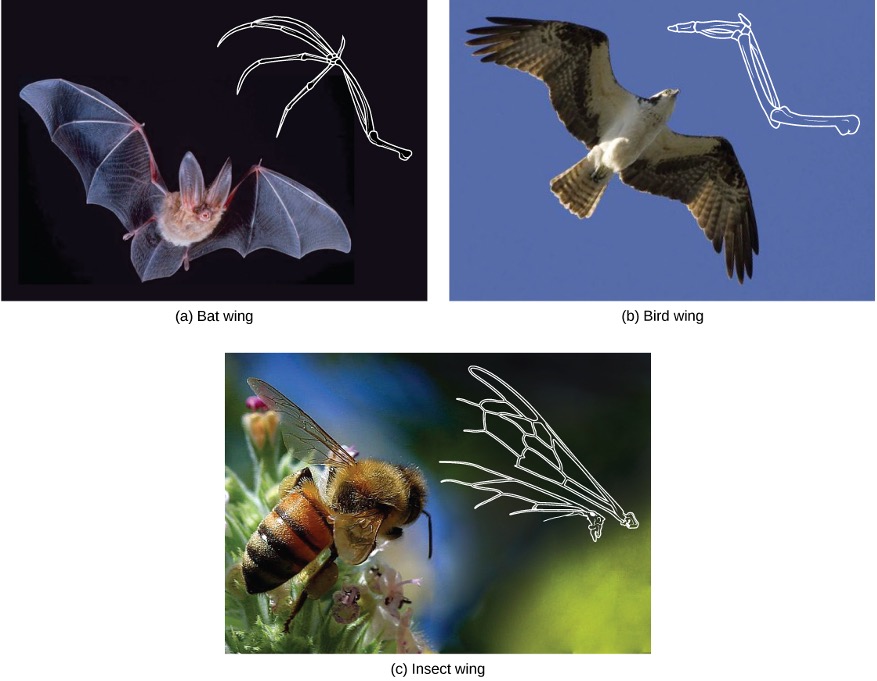
Read
Read Misinterpretations about relatedness: Misinterpretations and intuitive ideas about relatedness. (n.d.) Berkeley University of California. This website has several examples to show how appearances can be misleading in understanding organisms’ phylogenetic relationships.
Molecular comparisons
The advancement of DNA technology has given rise to molecular systematics, which is use of molecular data in taxonomy and biological geography (biogeography). New computer programs not only confirm many earlier classified organisms, but also uncover previously made errors. As with physical characteristics, even the DNA sequence can be tricky to read in some cases. For some situations, two very closely related organisms can appear unrelated if a mutation occurred that caused a shift in the genetic code. Inserting or deleting a mutation would move each nucleotide base over one place, causing two similar codes to appear unrelated.
Sometimes two segments of DNA code in distantly related organisms randomly share a high percentage of bases in the same locations, causing these organisms to appear closely related when they are not. For both of these situations, computer technologies help identify the actual relationships, and, ultimately, the coupled use of both morphologic and molecular information is more effective in determining phylogeny.
Shared characteristics
Organisms evolve from common ancestors and then diversify. Scientists use the phrase “descent with modification” because even though related organisms have many of the same characteristics and genetic codes, changes occur. This pattern repeats as one goes through the phylogenetic tree of life:
- A change in an organism’s genetic makeup leads to a new trait which becomes prevalent in the group.
- Many organisms descend from this point and have this trait.
- New variations continue to arise: some are adaptive and persist, leading to new traits.
- With new traits, a new branch point is determined.
Taxonomy is a subjective discipline: many organisms have more than one connection to each other, so each taxonomist will decide the order of connections.
To aid in the tremendous task of describing phylogenies accurately, scientists often use the concept of maximum parsimony, which means that events most likely occurred in the simplest, most obvious way. This is based on best assumption, however does not necessarily always correct. For example, if a group of people entered a nature reserve to hike, based on the principle of maximum parsimony, we would predict that most would hike on established trails rather than forge new ones. In reality, it is entirely possible that they took any number of alternative routes.
For scientists deciphering evolutionary pathways, the same idea is used: the pathway of evolution probably includes the fewest major events that coincide with the evidence at hand. Starting with all of the homologous traits in a group of organisms, scientists look for the most obvious and simple order of evolutionary events that led to the occurrence of those traits.
Read
Read Using parsimony. (n.d.) Berkeley University of California to learn how researchers use maximum parsimony to create phylogenetic trees.
These tools and concepts are only a few strategies scientists use to tackle the task of revealing the evolutionary history of life on Earth. Recently, newer technologies have uncovered surprising discoveries with unexpected relationships, such as the fact that people seem to be more closely related to fungi than fungi are to plants. Sound unbelievable? As the information about DNA sequences grows, scientists will become closer to mapping the evolutionary history of all life on Earth.

